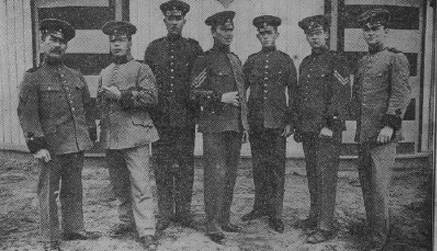Military Service (1916 - 1921) Pensions Collection
The Complexity of Loyalty
“No man can honestly serve two masters; no man can honestly serve Ireland and serve England.”
Themes: Divided Loyalties Sub-themes:
Subject: History,English Language: English
Estimated Number of Classes: 3
Toolkit: Projector,Internet Connection,Computer Lab

Abstract:
In this lesson plan students will gain a deeper and more nuanced understanding of the concepts of loyalty, nationalism and unionism. Students will utilise their understanding of these concepts in analysing a wide‐range of related primary source material.
Students will identify the various groupings that would have considered themselves as loyal to Ireland (the Dublin Metropolitan Police; the Royal Irish Constabulary; Irish soldiers in the British army; the Irish Volunteers), and will be asked to consider how these groupings viewed each other.
Students will be presented with different parts of the Maurice Meade Witness Statement as unattributed documents. At the end of the analysis of these contrasting conceptions of loyalty to Ireland it will be revealed that the excerpts are from the same Witness Statement so as to illustrate the divided loyalties of one individual.
Lesson Aims/Objectives:
a. To gain a deeper and more nuanced understanding of the concepts of loyalty, nationalism and unionism
b. To utilise their understanding of these concepts in analysing a range of primary source material
c. To identify the various groups that would have seen themselves as loyal to Ireland
(DMP; RIC; Irish in the British army; Irish Volunteers), and to consider how these groups viewed each other.
Advanced Preparation Required:
a. Teacher should familiarise themselves with the assigned sources before the class (see Materials Needed sections ‘a’ - ‘e’)
b. Teacher should prepare Maurice Meade Witness Statement (see Materials Needed section ‘f’) as an unattributed document (the author’s name is redacted).
Methodology:
a. Exercise one: Materials Needed sections ‘a’ ‐ ‘e’) section ‘f’) as an unattributed document (the author’s name is redacted).
i. Class is divided into five groups
ii. Each group is assigned a document (see Materials Needed sections ‘a’ ‐ ‘e’):
4. Oct. 1915 Recruitment Appeal
5. Pamphlet warning women about stepping out with men in British uniform
iii. Groups must analyse their document and identify what they believe to be their author’s idea of loyalty to Ireland
iv. Each group presents their findings to the class
v. Teacher‐led discussion on the varying concepts of loyalty which appear across the sources
b. Exercise two:
i. Class will be divided into two groups
ii. Both groups will be provided with different sections from the witness statement of Maurice Meade (see Materials Needed section ‘f’)
- Meade served both in the British forces (pages 7 ‐ 8) and in the rebel forces of 1916 (10 ‐ 13)
- The name should be removed from the statements so that both groups do not realize they have a statement from the same person
iii. One group will be presented with Meade’s account of his service in the war and the other will be given Meade’s account of his service in the Rising
iv. Students will have several minutes to discuss what their unidentified author does/says with the aim of ascertaining his concept of loyalty
v. Each group will then present their findings to the rest of the class
vi. After both presentations the teacher will reveal that the statements were written by the same person and ask the class whether this changes their perception of loyalty
Assessment:
a. Teacher observation of group interactions.
b. Questioning of students’ analysis of sources, this could form the basis of a formal written essay.
c. Teacher can assess students’ completion of the unattributed document activity and discussion of one individual’s divided loyalties, for their understanding of the concepts and the challenges faced in exploring primary source material.
Materials Needed:
a. The Witness Statement of Patrick Bermingham of the DMP (Pages 1‐4)
b. Witness Statement of George Chester Duggan (Page 6‐7)
c. Witness Statement of Eugene Bratton (Pages 1‐4 & 13)
d. Oct. 1915 Recruitment Appeal
e. Pamphlet warning women about stepping out with men in British uniform
f. Maurice Meade Witness Statement:
Funded/developed by
Developed by The Letters of 1916 Project, The Military Archives, An Foras Feasa and The Humanities Institute at Maynooth University. Funded by the Department of Education and Skills and the Irish Research Council.
 <200b>img-responsive">
<200b>img-responsive"> <200b>img-responsive pull-right">
<200b>img-responsive pull-right">

